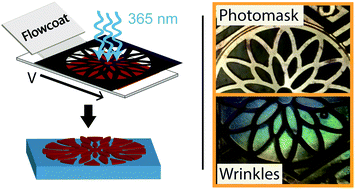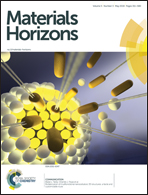Rapid and controlled photo-induced thiol–ene wrinkle formation via flowcoating†
Abstract
Spatially controlled wrinkle formation on an elastomeric substrate is achieved through flowcoating of a nanometer thick, high modulus thiol–ene film laminated on a millimeter-thick thiol–ene elastomer. The elastomer substrate is formed via photopolymerization of thiol and ene monomers with a slight stoichiometric excess of thiol to yield a 2.3 MPa elastomer. Separately, thiol and ene monomers, with a higher degree of functionality, are flow coated onto a glass slide and photopolymerized under ambient conditions to yield a 1.9 GPa film tens of nanometers thick. The photocrosslinked thin film is transferred onto the strained elastomer to spontaneously produce wrinkles upon strain release. Careful selection of thiol and ene monomers facilitate tuning of the film and elastomer mechanical properties, while stoichiometry control (i.e., excess thiols in the elastomer and excess enes in the film) allows covalent attachment of the film to the elastomer to prevent delamination upon elastomer destrain. Photopatterning of a flowcoated thin film is demonstrated, which, when wrinkled, generates a very distinct pattern of aligned wrinkle structures with clearly defined boundaries. Finally, by coating and photopatterning in sequence, spatial wrinkle wavelength control is readily attained by defining the film thickness at any given point.



 Please wait while we load your content...
Please wait while we load your content...